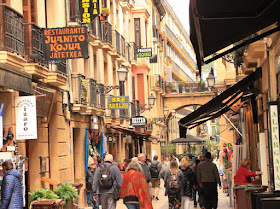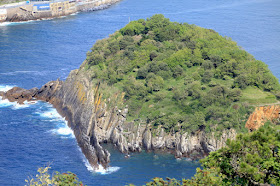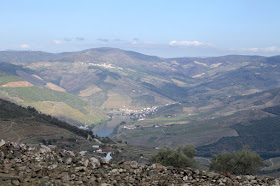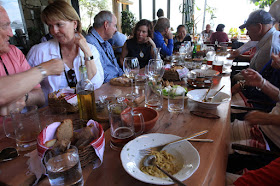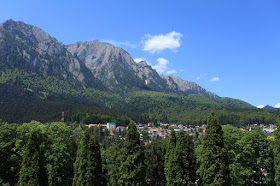Flying form Romania to Spain, we had a excellent view of the southern side of the Alps. A recent snow storm had dropped fresh snow just the day before. The captain said that the Matterhorn was visible out there but I didn't see it.
Northern Spain was so green!
Bilbao, Spain
Our first stop was the famous Guggenheim Museum. I didn't know too much about it but was pleasantly surprised at some of the exhibits (although many modern art museum will have some strange themes.
The spider at the entrance.
Tulip art. This piece is quite large.
This is one example of a seemingly strange exhibit. Imagine a hall as long as a football filed and in it are merely eight steel shapes. I walked in and said, "What is this?" But after walking into the shapes and seeing all of the different designs, it was AMAZING!
Here is the big view. We use tour guide systems on these trips in which a local guide can talk into a radio powered headset and then. we all can hear the guide without the need to stand real close. If you go more than 35 meters away, the signal fails. However, I went deep into three or four of these shapes on the far side of the hall and the guides voice came through loud and clear. The steel shapes act like an antennae.
San Sebastian, Spain
We stayed at the town of San Sebastian on the Bay of Biscay.
The old town was really wonderful and all of the "foodies" on our trip loved this stop as San Sebastian is known for its gastronomy. Some members of our group had made a reservation at a restaurant one year in advance and paid $500 for a 26-course meal. The portions were thumbnail size I heard.
Another scene on a street in the old town.
One of the churches in San Sebastian.
Across the bay is Mt. Urgill and I next went to the hotel seen on top. The following photos are taken from there.
On Mt. Urgill looking west.
Looking east into the bay and the spectacular setting of San Sebastian. The old town is seen just above the island in the bay.
Close-up of one of San Sebastian's beaches.
Close-up of the old town.
Note the upturned strata on the island. This reflects uplift of the Pyrenees Mountains whose main mass is located east of here. However, the entire region was caught up in the uplift event.
The Pyrenees have had multiple deformation episodes but the latest one was the Alpine Orogeny that created the Alps.
The road cuts near here are spectacular.
Barritz, France
I signed on for a day tour across the border in southern France and loved it.
A map of Spain and Portugal to show these locations. Note the towns of Bilbao and San Sebastian on the north coast of Spain near the French border. Just across the border is the village of Biarritz. Note also that this is the place where the orientation of the shoreline shifts from east-west to north-south. Biarritz is located right there.
This is looking from the area of the lighthouse to the east where rocks from the Pyrenees uplift are located.
Turning 90 degrees right note only a flat sandy coast. This is where the elbow of the Bay of Biscay is located. No mountains looking in this direction all the way to Normandy. This is a former plate junction where the Iberian microcontinent collided with Europe (France).
In Biarritz I visited the market.
France hams for sale. I would have loved to taste it.
The fruit stall.
Fresh fish from the Bay of Biscay. Look how nicely they are displayed. This was one of the cleanest markets I have ever seen.
Visiting the Virgin Mary statue on the bay. Note the tilted sedimentary rocks.
View to the west toward San Sebastian. Our day trip to France was excellent! And our stop in Spain was great too. On to Portugal!
The Coa Valley, Portugal
Our jet took a short flight to Porto in Portugal and we drove 90 minutes to the Douro Valley. The Douro River is a major waterway in northern Iberia. For the Douro Valley, I partook in a day trip to an archaeological site in the Coa Valley.
Through the wine growing region of northern Portugal. It is very scenic. I was very eager to see the Coa Valley because it is the site of a Paleolithic rock art site. The rock art here is between 25,000 and 10,000 years old. Many people have heard of the famous cave paintings in France and Spain and this site is partially equivalent in age.
The Douro River Valley where the Coa River meets this river. Note the river cruise boat.
The museum at the site had perfect recreations of the art as well as excellent exhibits. This is a recreation piece of one of the more famous elements. It is a depiction of a horse with seemingly two heads, one looking each way. But the archaeologists believe the artists were trying to depict motion.
The archaeological site has an interesting story. In 1991 a dam was set to be built on the Coa River shown here. As part of the pre-construction archaeological survey, they found the Paleolithic rock art. The energy company tried to find that the art was not of that age but it was futile. A national campaign was begun and by 1995 the dam project was halted forever. The dam site can be seen on the left side of this photo. What a great story. Read more about it here.
The way in was on dirt roads. The site is limited to about 50 people per day and there were 15 guests in our group.
The last town before the site is Castillo Melhor and the local restaurant is in on the theme.
A larger view of the site with the big floodplain bar likely the site where the artists camped. To think of Homo sapiens living here 25,000 years ago in the height of the Ice Age is thrilling to me.
The first panel being explained by our archaeology guide Antonio Barata. He has worked with rock art at this site since the days of dam construction.
When we arrived the panel was in the shade. But within 10 minutes the sun had drawn high snout to illuminate the elements. Many elements overlap one another and irregularities in the rock are sometimes used for eyes, noses, and other features.
This is a depiction of a horse on the left facing right. There are three heads on the torso which is very evident on the left. Antonio believes that the artists were depicting motion as the horse was grazing with its head down (easily seen at center), then lifting its head in two other positions above that.
Antonio pointing out the site.
A fabulous rendition of an aurochs, a wild predecessor of domesticated cattle. The last aurochs died in Poland in 1837.
More elements on the rock. Our group was ecstatic to see such ancient art.
Look at this! The rock type is schist.
Thank you for reading about my trip - Kingdoms and Cultures of Eurasia!









